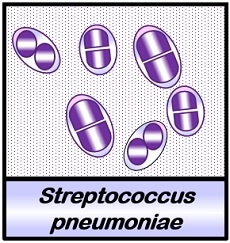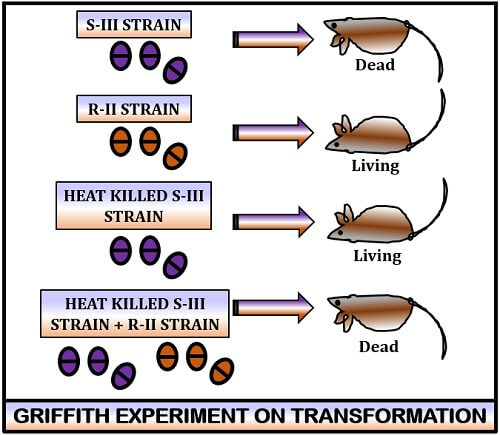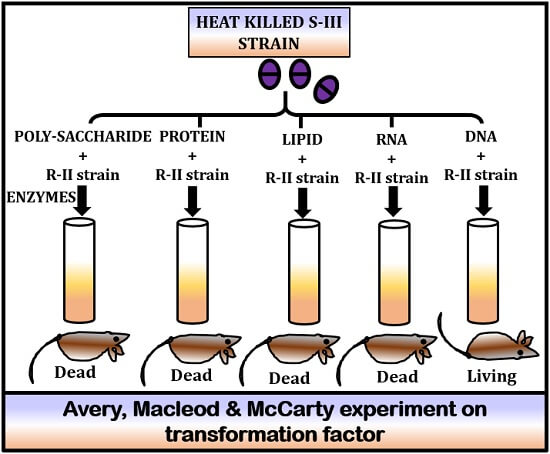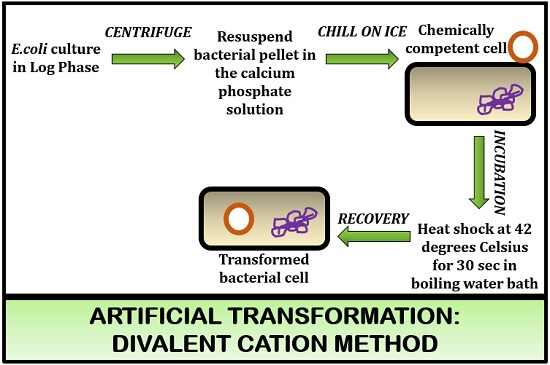Transformation in bacteria was first studied by a scientist Frederick Griffith in 1928. According to Griffith, the DNA or gene transfer can occur either naturally or artificially from one type of bacteria to another. For example, Transformation of non-virulent strain to a virulent cell or vice versa.
To explain the transformation principle, Griffith performed certain experiments on the mice by taking pathogenic bacteria Streptococcus pneumoniae. Transformation results in gene alteration in the recipient cell, due to the incorporation of free DNA from its surrounding through the cell membrane.
The transformation process is widely used in gene cloning, DNA linkage, generation of cDNA libraries and protein expression. Here, we will discuss the definition, stages, competence in the transformation of bacteria. You will also get to know the transformation principle of the bacteria through the Griffith experiment (transformation experiment).
Content: Transformation in Bacteria
- Definition of Transformation
- Streptococcus pneumoniae
- Strains used in Griffith Experiment
- Transformation Experiment
- Transforming Factor
- Stages of Transformation
- Competence
- Conclusion
Definition of Transformation
Transformation can define as the process of taking up of an extracellular or free DNA strand of one bacterial cell (donor’s cell) by the competent bacterial cell (recipient’s cell). The taking up of the DNA strand occurs either by natural or artificial means. The transformation occurs mostly in the closely related species. Therefore, transformation merely refers to the direct insertion, incorporation and expression of the exogenous DNA in the competent bacterial cell (gets transformed by the inclusion of free DNA).
Streptococcus pneumoniae
Classification:
- Kingdom: Bacteria
- Phylum: Firmicutes
- Class: Bacilli
- Order: Lactobacillales
- Family: Streptococcaceae
- Genus: Streptococcus
- Species: pneumoniae
Streptococcus pneumoniae are the gram-positive bacteria, which are mostly diplococci, non-motile and non-spore formers. The cell wall of Streptococcus pneumoniae is encapsulated with polysaccharide, and it imparts virulency to the bacteria. Streptococcus pneumoniae is the strain of bacteria used to demonstrate the principle of transformation by Griffith. This strain was also used by the three scientists Avery, Macleod and McCarty to identify the transferring factor.

Strains used in Griffith Experiment
To demonstrate the transformation principle, Frederick Griffith had taken the pathogenic bacteria Streptococcus pneumoniae. Further, he observed two different strains of Streptococcus pneumoniae and named it as S-III and R-II strain.
- S-III strain: It is the smooth strain of Streptococcus pneumonia, which is encapsulated with the polysaccharide. S-III strain will act as virulent or wild strain, as the polysaccharide is a virulent factor.
- R-II strain: It is the rough strain of Streptococcus pneumonia, which lacks the polysaccharide covering. The R-II strain will act as mutant or avirulent strain, as the polysaccharide is absent.
Transformation Experiment
To explain the theory of transformation principle, Frederick Griffith performed a series of experiments where he injected two different strains of Streptococcus pneumoniae into the mice and reported the particular strain’s effect into the mice.
- In his first experiment, Griffith used a rough strain of Streptococcus pneumonia (R-II) and injected it into the mice. After doing this, he observed that the R-II strain of bacteria did not affect the mice and the mice lived. Therefore, Griffith named R-II strain as an “Avirulent strain”.
- In his second experiment, Griffith used a smooth strain of Streptococcus pneumonia (S-III) and injected it into the mice. After doing this, he observed that the S-III strain of bacteria killed the mice. Therefore, Griffith named S-III strain as a “Virulent strain”.
- In the third experiment, Griffith used smooth or virulent S-III and subjected it to the heat to destroy the virulence. Then, he injected the heat-killed S-III strain into the mice. After doing this, he observed that the heat-killed S-III strain did not affect the mice and the mice lived. Therefore, Griffith concluded that the virulence of the S-III strain becomes ineffective the heat exposure.
- In the fourth experiment, Griffith used rough R-II strain plus dead or heat-killed S-III strain and injected into the mice. After that, he observed the death of mice. Then, he concluded that the S-III strain had transferred something which transformed the R-II strain into the virulent strain (R-III) and caused the death of mice.

Therefore, Griffith, in his experiment, concluded that there is a transformation factor, which has caused the transformation of the sensitive strain to virulent type. According to him, the transforming factor was a protein, which he was not sure about.
Transforming Factor
To explain the transformation factor (whether it was a protein or some other component), Avery, Macleod and McCarty performed a series of experiments. Their experiment to identify the transformation of R-II to virulent type can be summarized into the following sequential steps:

- First, they extracted different components like protein, polysaccharide, lipid, RNA and DNA from the heat-killed S-III strain.
- After that, they added R-II strain individually into each test tubes.
- In the third step, they used specific enzymes for the digestion of specific components.
- Then, they injected it to the mice.
After doing this experiment, they observed the death of four mice except for the last one. They concluded that the DNA is the transformation factor which has transformed the R-II strain to the virulent type. Therefore, the DNA is the heritable material that has transferred the virulence from the dead or heat-killed S-III strain to the R-II strain.
As the DNA of S-III or virulent strain is destroyed by the enzyme DNase, there will not be any transformation between the heat-killed S-III strain and the R-II strain, and thus there will be no effect on the mice. They also concluded that even though the polysaccharide is a virulent factor, but still it is not involved in the transformation as it is not heritable.
Stages of Transformation
There are three stages of transformation which include:
- Competence is the first stage where a cell must be competent to take up the DNA. To develop competence, the cell responds to the environmental signal, allowing the binding and penetration of the free DNA.
- The DNA binding is the second stage of transformation in which the exogenous or free DNA binds to the recipient’s cell wall due to developed competence. This stage occurs at the time of incubation of bacterial cell culture on ice. The DNA will bind to the recipient cell wall of bacteria by forming calcium chloride plus a DNA complex.
- DNA integration is the incorporation of the exogenous DNA that has entered to the recipient cell cytoplasm. Therefore, the insertion of foreign DNA into the chromosome of the recipient cell will cause transformation.
Competence
To carry out the transformation process, the bacteria should be competent to take up the free DNA. Competence can define as the physiological state, where a recipient cell is in a state where it can respond to the environmental conditions such as starvation and cell density. Therefore, when a cell becomes competent, it can take up the exogenous DNA from the donor’s cell.
In the process of transformation, competence can be of two types:
- Natural competence
- Artificial competence
Natural competence
It is a type where a transformation occurs naturally in response to environmental signals and extreme conditions. About 1% of bacteria can develop competence naturally. A set of genes are carried by the naturally competent bacteria. The genes (DNA) then migrate across the cell membrane naturally and infuse within the recipient’s cell.

Artificial competence
In this type, a transformation is induced artificially by some chemical or physical methods. Thus, the transformation process is forced or do not occur naturally. Artificial competence can be achieved by both chemical and physical methods. The artificial competence can be achieved by the chemical method through the divalent cation method and physical method through the electroporation.
Divalent cation method: It was first introduced by the two scientists Mandel and Higa in 1970. In the divalent cation method, the E.coli in the log phase of growth are taken from the culture. Then, E.coli culture is centrifuged. From the E.coli culture, the pellet of bacteria is resuspended in the divalent ion solution like calcium chloride. After that, the culture is kept under cold conditions that result in the weakening of bacteria’s cell surface and allow the binding of free DNA molecule.

Then, the bacterial suspension is suddenly subjected to the high temperature (42 Degrees Celsius) for 30 seconds in the boiling water bath, and the process called heat shock. It results in the thermal imbalance within the bacterial cell and forces the binding of free DNA into the cell.
Electroporation: It is an alternative method of chemical transformation. In electroporation, the bacterial cell is subjected to a high voltage of 15 kV/cm for a 5 µ sec under the influence of an electric field, and the process is called electroshock. The electric shock enhances the ability to take up the free DNA strand. In 1982, a technique of introducing free DNA into the mice was carried out by a scientist Neumann where he treated it with the short pulses at high voltage.

Neumann concluded that the electric shock increases the cell’s membrane potential and thereby increases the cell permeability to take up the charged molecule like DNA.
Conclusion
We can conclude that the non-competent cell has to be competent to carry out the transformation. The competence is developed by the environmental signals like temperature, pH, heat etc., making the cell competent by enhancing the ability to take up the free DNA.